SETH GREEN
History is not always as clear-cut as we would like it to be. Such is the case with the pattern I present to you today. This 'Seth Green' was created by Clarence Roberts, a famous Michigan tyer of the 1950s.
As the story goes --- Clarence had a fishing buddy and fellow conservation office, with whom he worked, named Seth Green. Presumably, the fly was named in his honor. The Department of Natural Resources can not confirm the existence of a Conservation Officer of that name, and the family of Clarence Roberts has no recollection of Clarence having known anyone named Seth Green.
Clarence's fly is very suggestive of a pattern created by a Mr. Seth Green of New York back in the mid to late 1800s. I would suggest to you that Clarence was familiar with the original pattern; and then created this --- his own version.

Materials:
- Hook: Mustad #94840 Size: 12
- Thread: Black, 6/0
- Tail: Woodchuck
- Wing: Grizzly, tied spent
- Rib: Yellow Monocord
- Body: Dark Olive Floss
- Hackle: Brown
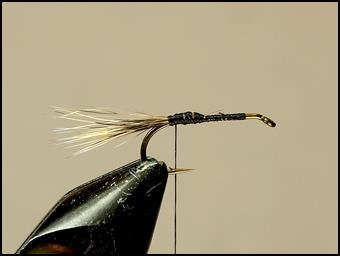 Tie in a good base of thread and then tie in the woodchuck tail, then run your thread forward.
Tie in a good base of thread and then tie in the woodchuck tail, then run your thread forward.
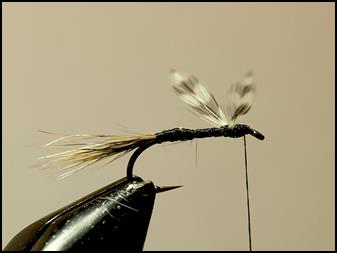 Select you grizzly hackle tips. Tie them in, spent wing style. Secure with thread.
Select you grizzly hackle tips. Tie them in, spent wing style. Secure with thread.
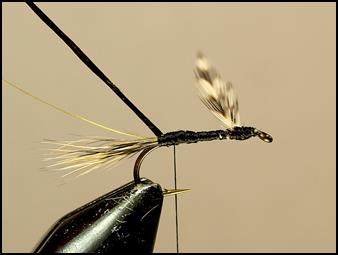 Tie in both your rib material (yellow thread) and your olive floss at the same time. Then run your thread forward. By doing this you will save having to bring your thread back down the body again.
Tie in both your rib material (yellow thread) and your olive floss at the same time. Then run your thread forward. By doing this you will save having to bring your thread back down the body again.
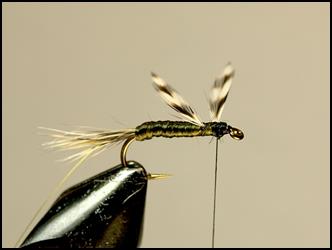 Now, wrap your floss forward and then secure it with thread.
Now, wrap your floss forward and then secure it with thread.
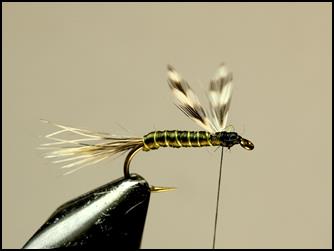 The yellow thread can now be palmered over the body and then secured with thread.
The yellow thread can now be palmered over the body and then secured with thread.
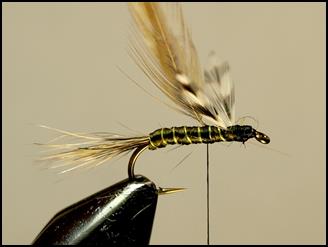 Select your hackle and tie it in just behind the wings.
Select your hackle and tie it in just behind the wings.
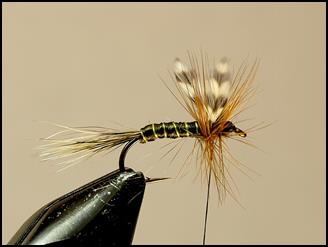 Wrap the hackle both behind and in front of the wings. Secure with thread.
Wrap the hackle both behind and in front of the wings. Secure with thread.
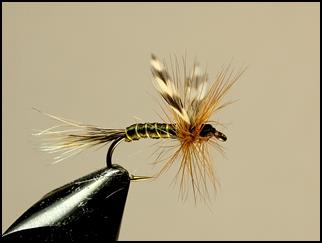 Normally I would remind you to now to lacquer the body, thus providing more durability to the fly. But, it place of lacquer I now use clear nail polish. It provides a much harder and more transparent finish to the fly then lacquer.
Normally I would remind you to now to lacquer the body, thus providing more durability to the fly. But, it place of lacquer I now use clear nail polish. It provides a much harder and more transparent finish to the fly then lacquer.
Seth Green was a famous fish culturist and fly tyer of New York. The original was a wet fly and was designed for bass fishing. There are several versions of his original pattern (both wet and dry) along with many other variations designed as dry flies.
I have never fished with Clarence's variation of this fly, but its design and coloration are such that I can think of a couple of hatches that I just might try it on.
See you on the water…..
Tom Deschaine
For more great info, check out:
Beginning Fly Tying | Intermediate Fly Tying | Advanced Fly Tying.
